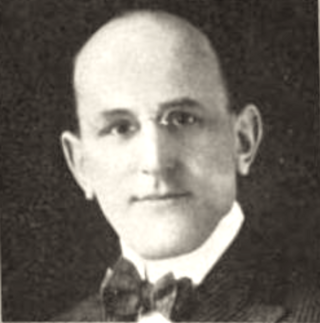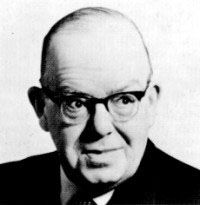
Fred Fisher was a German-born American songwriter and Tin Pan Alley music publisher.

Music hall is a type of British theatrical entertainment that was most popular from the early Victorian era, beginning around 1850, through the Great War. It faded away after 1918 as the halls rebranded their entertainment as variety. Perceptions of a distinction in Britain between bold and scandalous music hall entertainment and subsequent, more respectable variety entertainment differ. Music hall involved a mixture of popular songs, comedy, speciality acts, and variety entertainment. The term is derived from a type of theatre or venue in which such entertainment took place. In North America vaudeville was in some ways analogous to British music hall, featuring rousing songs and comic acts.
Knowles Fred Rose was an American musician, Hall of Fame songwriter, and music publishing executive.

By the Light of the Silvery Moon is a 1953 American musical film directed by David Butler and starring Doris Day and Gordon MacRae. As with the film's predecessor On Moonlight Bay, the film is based loosely on the Penrod stories by Booth Tarkington.

"Lily of Laguna" is a British coon song written in eye dialect. It was written in 1896 by English composer Leslie Stuart. It was a music hall favourite, performed notably by blackface performers such as Eugene Stratton and G. H. Elliott. In the early 1940s Ted Fio Rito wrote the tune of a new verse and Paul Francis Webster wrote fresh lyrics and it was stripped of its overtly racist lyrics to become a pure love song which continued to be popular into the 1950s.

"By the Light of the Silvery Moon" or "By the Light of the Silv'ry Moon" is a popular love song. The music was written by Gus Edwards, and the lyrics by Edward Madden. The song was published in 1909 and first performed on stage by Lillian Lorraine in the Ziegfeld Follies of 1909. It was one of a series of moon-related Tin Pan Alley songs of the era. The song was also used in the short-lived Broadway show Miss Innocence when it was sung by Frances Farr.

Eugene Augustus Rühlmann was an American-born dancer and singer. He adopted the stage name Eugene Stratton and spent most of his career in British music halls.

Coon songs were a genre of music that presented a stereotype of Black people. They were popular in the United States and Australia from around 1880 to 1920, though the earliest such songs date from minstrel shows as far back as 1848, when they were not yet identified with "coon" epithet. The genre became extremely popular, with White and Black men giving performances in blackface and making recordings. Women known as coon shouters also gained popularity in the genre.

Charles Denier Warren was an Anglo-American actor who appeared extensively on stage and screen from the early 1930s to late 1960s, mostly in Great Britain.

St Margaret's Church is an Anglican church in the village of Rottingdean, in the city of Brighton and Hove, England. It is the parish church of Rottingdean, which became part of the former Borough of Brighton in 1928. Parts of the structure date from the 13th century, and it is a Grade II* listed building.
Sir Michael Rudolf Stratton is a British clinical scientist and the third director of the Wellcome Trust Sanger Institute. He currently heads the Cancer Genome Project and is a leader of the International Cancer Genome Consortium.

Variety Jubilee is a 1943 British historical musical film directed by Maclean Rogers and starring Reginald Purdell, Ellis Irving and Lesley Brook. It depicts life in a London music hall from 1892 to the Second World War. It was made at the Riverside Studios in Hammersmith. The film was re-released in 1945, to capitalise on the popularity of Ealing's Champagne Charlie.
Thomas Patrick Finglass was an Irish blackface tenor who had a successful career in British music hall. He was sometimes billed as The Ideal Coon. He played the legendary blackface performer Eugene Stratton (1861–1918) in the 1940 film You Will Remember which tells the story of songwriter Leslie Stuart's (1863–1928) life.

Talbot O'Farrell was an English music hall and variety show singer whose repertoire included both sentimental and comic songs. Early in his career he used the stage names WillMcIver.

Margaret Stallard is a British actress best known for playing Mrs Babbitt in Crossroads and Grace Tolly in Emmerdale.

Johnny Danvers was an English actor, comedian and music hall performer who made a number of appearances in the annual pantomime at the Theatre Royal, Drury Lane in the late 19th and early 20th-centuries, usually with his nephew Dan Leno.
The Chocolate Kiddies is a three-act Broadway-styled revue that, in its inaugural production – from May to September 1925 – toured Berlin, Hamburg, Stockholm, and Copenhagen. The show never actually performed on Broadway, but was conceived, assembled, and rehearsed there. Chocolate Kiddies commissioned new works, but was also an amalgamation and adaptation of several leading African American acts in New York, specifically Harlem, intended to showcase exemplary jazz and African American artistry of the Harlem Renaissance. Early jazz was uniquely American; and, while New Orleans enjoys popularity for being its birthplace, the jazz emerging from Harlem during the Renaissance had, on its own merits, captured international intrigue.
Donald Ross was an English music hall performer, theatre producer and promoter.
In the American vaudeville and British music hall traditions, the bill matter was the identifying phrase used in advertising material to describe and summarize the appeal and attributes of each performer or group of performers. Each was considered as a trademark, not to be used by other performers. Examples in Britain included George Robey, "The Prime Minister of Mirth"; G. H. Elliott, "The Chocolate Coloured Coon"; Max Miller, "The Cheeky Chappie"; and Billy Bennett, "Almost a Gentleman".














